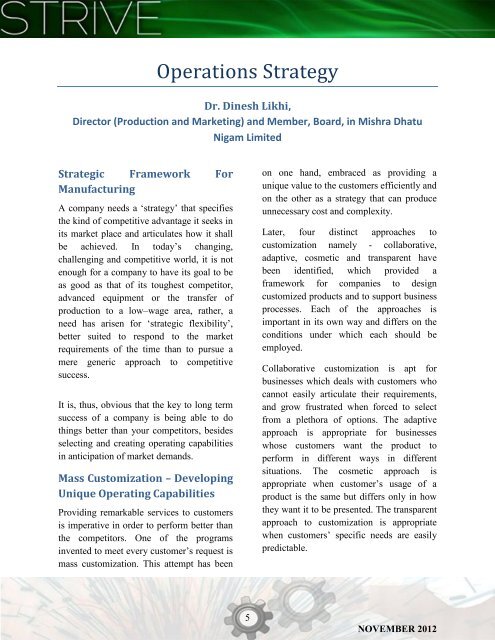sTRIVE final.pdf
Create successful ePaper yourself
Turn your PDF publications into a flip-book with our unique Google optimized e-Paper software.
Operations Strategy<br />
Dr. Dinesh Likhi,<br />
Director (Production and Marketing) and Member, Board, in Mishra Dhatu<br />
Nigam Limited<br />
Strategic Framework For<br />
Manufacturing<br />
A company needs a ‘strategy’ that specifies<br />
the kind of competitive advantage it seeks in<br />
its market place and articulates how it shall<br />
be achieved. In today’s changing,<br />
challenging and competitive world, it is not<br />
enough for a company to have its goal to be<br />
as good as that of its toughest competitor,<br />
advanced equipment or the transfer of<br />
production to a low–wage area, rather, a<br />
need has arisen for ‘strategic flexibility’,<br />
better suited to respond to the market<br />
requirements of the time than to pursue a<br />
mere generic approach to competitive<br />
success.<br />
It is, thus, obvious that the key to long term<br />
success of a company is being able to do<br />
things better than your competitors, besides<br />
selecting and creating operating capabilities<br />
in anticipation of market demands.<br />
Mass Customization – Developing<br />
Unique Operating Capabilities<br />
Providing remarkable services to customers<br />
is imperative in order to perform better than<br />
the competitors. One of the programs<br />
invented to meet every customer’s request is<br />
mass customization. This attempt has been<br />
on one hand, embraced as providing a<br />
unique value to the customers efficiently and<br />
on the other as a strategy that can produce<br />
unnecessary cost and complexity.<br />
Later, four distinct approaches to<br />
customization namely - collaborative,<br />
adaptive, cosmetic and transparent have<br />
been identified, which provided a<br />
framework for companies to design<br />
customized products and to support business<br />
processes. Each of the approaches is<br />
important in its own way and differs on the<br />
conditions under which each should be<br />
employed.<br />
Collaborative customization is apt for<br />
businesses which deals with customers who<br />
cannot easily articulate their requirements,<br />
and grow frustrated when forced to select<br />
from a plethora of options. The adaptive<br />
approach is appropriate for businesses<br />
whose customers want the product to<br />
perform in different ways in different<br />
situations. The cosmetic approach is<br />
appropriate when customer’s usage of a<br />
product is the same but differs only in how<br />
they want it to be presented. The transparent<br />
approach to customization is appropriate<br />
when customers’ specific needs are easily<br />
predictable.<br />
5<br />
NOVEMBER 2012







